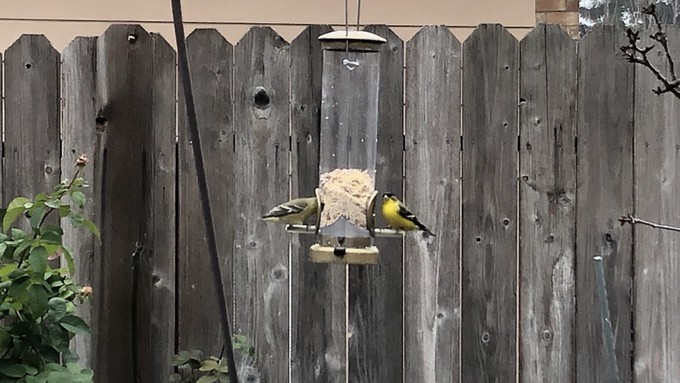
Feathered friends need food help in winter

A pair of lesser goldfinches dine at a mixed-seed feeder. Birds need more energy in winter to survive the cold. Kathy Morrison
Gardening is turning me into a birdwatcher.
In the 10 days since I hung my new bird feeder in the backyard, I’ve identified an oak titmouse or two, several dark-eyed juncos, some lesser goldfinches, the punk-looking white-crowned sparrow, one gold-crowned sparrow and some house finches, looking so festive with their reddish feathers.
These have joined the neighborhood regulars: the scrub jays, mourning doves, Bewick’s wrens and hummingbirds that frequent our trees and shrubs. I also have heard the northern mockingbird pretty often, but haven’t had a visual identification.
I’m thrilled to see all these little birds enjoying their seeds and exhibiting bits of personality, too.The juncos are the earliest risers, hopping around on the ground and in containers of the potted roses. Then finches and sparrows arrive at the feeder in bunches, the goldfinches shoving each other out of the way to get to the mixed seed selection. The small cherry tree nearby has become the birds’ waiting area, so I hung a bell-shaped seed cake there to augment the offerings – though it might not survive long against the neighborhood squirrels. (The feeder is on a hook the squirrels can’t reach.)
Winter can be a tough time for resident birds, since insects are dormant and many plants are, too. They also need more energy to stay warm. I’ve been working to make the garden more friendly to all natives – insects and other pollinators as well as birds: planting more natives, eliminating the back lawn, keeping some of the ground bare, letting leaves lie where they fall, and avoiding use of pesticides and herbicides. (A gentleman who came to repair the back fence called my garden “a mess,” but what does he know? It’s living and lively.) And now the bird feeder is open for winter business.
These sustainability practices, I discovered to my delight, are not only great for the natural environment, they also make my yard eligible to become a Certified Wildlife Habitat. I have a little more work to do but am looking forward to the day I can display the sign from the National Wildlife Federation. That will be a gift for all of us.
By the way, the Audubon Society has this list of ways to make your home more bird-friendly.
And if you’d like help identifying birds in your yard, I can recommend the Sacramento Audubon Society’s online list of Sacramento area birds as well as the Cornell Lab of Ornithology’s Merlin app. Merlin allows you to record on your phone the call or song of a bird you can’t see – which is how I got the northern mockingbird identified. I’m still a beginner in this area, but it is great fun.
P.S. Mark your calendar for the Great Backyard Bird Count, coming up Feb. 17-20, 2023.
Comments
0 comments have been posted.Sacramento Digs Gardening to your inbox.
Food in My Back Yard Series
May 6: Maintain soil moisture with mulch for garden success
April 29: What's (already) wrong with my tomato plants?
April 22: Should you stock up on fertilizer? (Yes!)
April 15: Grow culinary herbs in containers
April 8: When to plant summer vegetables
April 1: Don't be fooled by these garden myths
March 25: Fertilizer tips: How to 'feed' your vegetables for healthy growth
March 18: Time to give vegetable seedlings some more space
March 11: Ways to win the fight against weeds
March 4: Potatoes from the garden
Feb. 25: Plant a fruit tree now -- for later
Feb. 18: How to squeeze more food into less space
Feb. 11: When to plant? Consider staggering your transplants
Feb. 4: Starting in seed starting
Sites We Like
Garden Checklist for week of May 11
Make the most of the lower temperatures early in the week. We’ll be back in the 80s by Thursday.
* Plant, plant, plant! It’s prime planting season in the Sacramento area. Time to set out those tomato transplants along with peppers and eggplants. Pinch off any flowers on new transplants to make them concentrate on establishing roots instead of setting premature fruit.
* Direct-seed melons, cucumbers, summer squash, corn, radishes, pumpkins and annual herbs such as basil.
* Harvest cabbage, lettuce, peas and green onions.
* In the flower garden, direct-seed sunflowers, cosmos, salvia, zinnias, marigolds, celosia and asters. (You also can transplant seedlings for many of the same flowers.)
* Plant dahlia tubers.
* Transplant petunias, marigolds and perennial flowers such as astilbe, columbine, coneflowers, coreopsis, dahlias, rudbeckia and verbena.
* Keep an eye out for slugs, snails, earwigs and aphids that want to dine on tender new growth.
* Feed summer bloomers with a balanced fertilizer.
* For continued bloom, cut off spent flowers on roses as well as other flowering plants.
* Add mulch to the garden to maintain moisture. Mulch also cuts down on weeds. But don’t let it mound around the stems or trunks of trees or shrubs. Leave about a 6-inch-to-1-foot circle to avoid crown rot or other problems.
* Remember to weed! Pull those nasties before they set seed.
* Water early in the day and keep seedlings evenly moist.